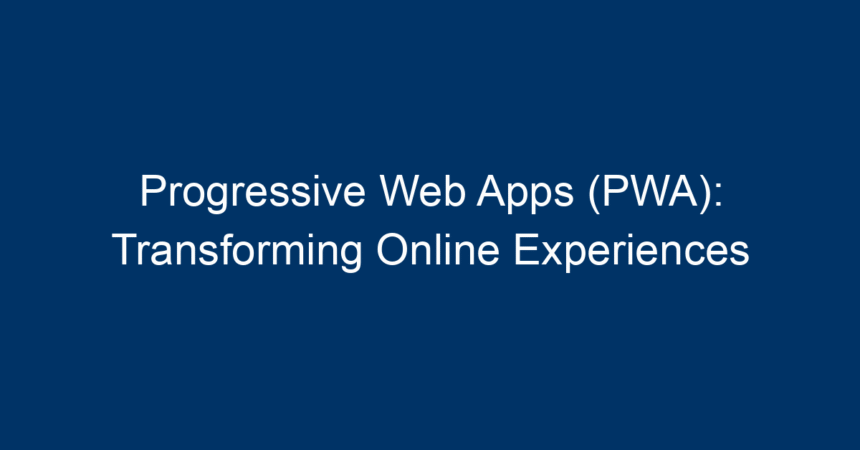In today’s fast-paced digital landscape, user expectations are higher than ever. As a result, businesses and developers are constantly seeking innovative ways to enhance the online experience. Enter Progressive Web Apps (PWA)—a technology that promises to revolutionize how users interact with websites and applications. Combining the best of web and mobile applications, PWAs offer seamless performance, offline capabilities, and a rich user experience. This article explores the transformative impact of PWAs on online experiences and provides actionable insights for businesses looking to adopt this technology.
What Are Progressive Web Apps (PWA)?
Progressive Web Apps (PWA) are web applications built using regular web technologies but designed to offer a native app-like experience. These apps leverage modern web capabilities to provide users with fast, reliable, and engaging interactions. Key features that distinguish PWAs include:
- Responsive Design: PWAs adapt seamlessly to different screen sizes, ensuring optimal performance on desktops, tablets, and mobile devices.
- Offline Support: Thanks to service workers, PWAs can function even without an internet connection, storing content and data for offline use.
- App-Like Navigation: PWAs provide smooth transitions and resource loading, similar to native apps, enhancing the user experience significantly.
- Installation on Home Screens: Users can add PWAs to their home screens, allowing easy access without going through app stores.
Why Progressive Web Apps (PWA) Matter
The adoption of PWAs is gaining momentum, and here’s why they matter:
1. Improved Performance and Speed
Performance is a critical factor for user satisfaction. Research has shown that even a one-second delay in loading time can lead to a significant decrease in conversion rates. PWAs utilize modern web capabilities, like service workers, to load content quickly and efficiently. By caching resources and preloading content, PWAs ensure minimal load times and a smooth experience for users.
2. Enhanced User Engagement
Engagement metrics play a vital role in retaining users and converting them into customers. Progressive Web Apps (PWA) enhance user engagement through features such as push notifications and offline capabilities. Push notifications help in re-engaging users by providing timely updates, while offline mode allows users to interact with the app even when they’re disconnected from the internet.
3. Broader Reach
With full responsiveness across devices, PWAs allow businesses to reach a wider audience. Whether users are on a desktop in their office or using a mobile device on the go, they can access the same app functionality. This capability is particularly beneficial in emerging markets where mobile internet usage outpaces desktop access.
4. Cost-Effective Development
Developing PWAs can be more cost-effective than creating separate applications for different platforms. Since PWAs use a single codebase, businesses can save time and resources while still delivering a high-quality user experience. This economic efficiency is especially appealing for startups and small businesses.
Key Features of Progressive Web Apps (PWA)
1. Service Workers
The backbone of PWAs, service workers are scripts that run in the background, enabling functionalities that don’t require a web page or user interaction. They manage caching, facilitate offline access, and handle push notifications effectively.
2. Web App Manifest
The web app manifest is a JSON file that describes a PWA’s settings and behaviors. It includes information like the app’s name, icons, start URL, and display options. This manifest enables users to install the PWA on their home screens and control how the app appears and behaves.
3. Responsive Design
PWAs utilize responsive web design techniques to ensure compatibility across different devices. This adaptability means that the user experience remains consistent regardless of the device or screen size.
4. Security
PWAs are served over HTTPS, ensuring that all data exchanged is secure and protecting users from snooping or man-in-the-middle attacks. This security aspect is critical in an era where data privacy is paramount.
How Businesses Can Leverage Progressive Web Apps (PWA)
Implementing PWAs can significantly enhance a business’s online presence. Here are some actionable insights for leveraging this technology:
1. Assess User Needs
Understanding your audience is the first step to successful PWA implementation. Conduct user surveys, analyze behavior patterns, and gather feedback to tailor the application to meet user needs effectively.
2. Focus on Performance
Prioritize speed and performance in your PWA development. Optimize images, minimize JavaScript, and utilize lazy loading techniques to ensure users enjoy a fast and responsive experience. Regularly test performance to identify and resolve bottlenecks.
3. Integrate Push Notifications
Use push notifications to keep users engaged and informed. Design an opt-in system that respects user preferences, and provide value in your notifications to encourage re-engagement without being intrusive.
4. Promote Installation
Encourage users to install your PWA by implementing clear prompts. Use enticing language and highlight the benefits of installation, such as offline access and fast loading times.
5. Continuous Improvement
Adopting a culture of continuous improvement is vital. Regularly gather analytics data, monitor user behavior, and be responsive to feedback. Continuous updates will keep your PWA relevant and aligned with user expectations.
Case Studies: Success Stories
1. Twitter Lite
Twitter Lite is a flagship example of a PWA that successfully transformed user experiences. By focusing on speed and performance, the app reduced its data usage by 70% and load times to under 3 seconds, resulting in a 65% increase in pages per session.
2. Starbucks
Starbucks developed its PWA to enhance user interaction with its mobile ordering system. This app offered a faster, more efficient way to place orders, seamlessly integrating into user routines and contributing significantly to revenue growth.
3. Forbes
Forbes saw improvements in load time and user engagement after implementing a PWA. The publication reported a dramatic reduction in bounce rates and a significant increase in readership due to the improved user experience.
Future Trends in Progressive Web Apps (PWA)
As technology continues to evolve, PWAs are likely to adopt even more advanced features, such as:
- Enhanced Personalization: Utilizing AI and machine learning for deeper insights into user preferences and behavior to create personalized experiences.
- Better Integration: Further integration with device hardware (like camera and GPS capabilities) will enhance functionality and user engagement.
- AR and VR Capabilities: The incorporation of augmented reality (AR) and virtual reality (VR) elements could provide immersive experiences in PWAs, especially in retail and entertainment sectors.
Conclusion
Progressive Web Apps (PWA) are reshaping how businesses and users interact online. By combining the best features of web and mobile applications, PWAs provide a solution to the challenges posed by traditional web and mobile apps. For businesses, adopting PWAs can lead to improved performance, greater user engagement, and cost-effective development.
In an era where the digital experience is paramount, embracing PWAs is not just an option—it’s a necessity. Take the plunge, leverage the power of PWAs, and transform your online presence today. Embrace the future of digital interaction, and ensure that your business meets and exceeds the ever-evolving expectations of users.




